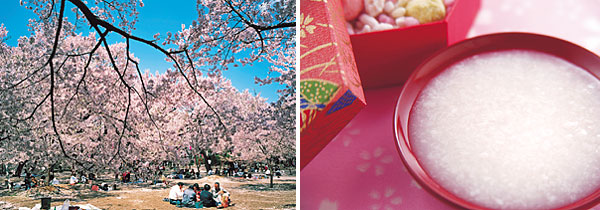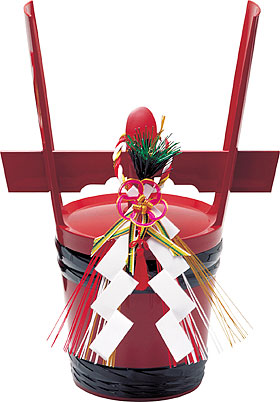Special Feature![]() Here’s to Japanese sake!
Here’s to Japanese sake!
Japanese liquor stores sell alcohol from all over the world, but for special occasions sake comes first. The idea that sake has something holy about it survives to this day. It is made from rice, the staple food of the country. When, long ago, the ancestors of the Japanese first prayed for a good rice harvest, we can assume that they were at the same time praying to the god of sake. The kami (god) is enshrined at Shinto places of worship throughout the country, including the ancient cities of Kyoto (Matsuo Taisha Shrine) and Nara (Omiwa Shrine).
During ceremonies and religious rituals sake is imbibed, of course, and it may also be presented as an offering, thrown at people in fun, and sprinkled on the ground. This is done to celebrate, to pray, to purify, or to placate a god. During New Year’s, the doll festival, and other sekku events that mark a certain time of the year, sake is offered to welcome the gods, and then it is drunk with food. When a major contract is signed, or when promises are made, it is drunk from special cups—the best example would be the san-san kudo “3 sips, 3 cups” exchange by a bride and groom.
As one season changes to the next, nature’s beauty changes too, providing another occasion to celebrate with sake. When the cherry trees bloom in the spring they invite people to party under them. The blossoms are a star attraction for today’s Japanese. And some people hold parties to view the moon in the fall, and the snow in winter.
The world of sake is rich in other ways as well—for instance, the wide variety of cups and bottles. White bottles hold sacred sake for the gods, symbolizing the pure and holy nature of sake. They have a quiet beauty of their own. Equally beautiful but quite different are the red and black lacquered containers, tastefully decorated with gold or silver. They make the auspicious occasion even more special.
And so you see, for Japanese people sake is more than just an alcoholic beverage—it forms an integral part of their culture and customs. ![]()

Above left: When the cherry blossoms are at their peak, it is almost like they are inviting people to party beneath their boughs with sake.
Above right: Sweet amazake sake served during the doll festival (March 3). This variety is made from a rice gruel and kome-koji, and has a low alcohol content.


